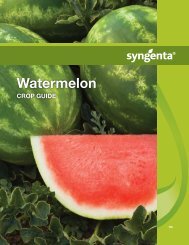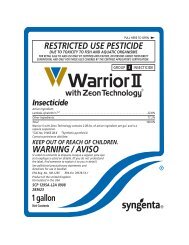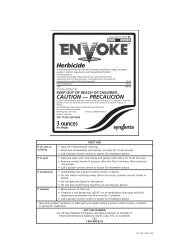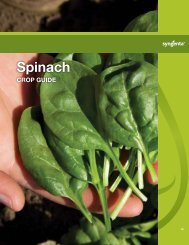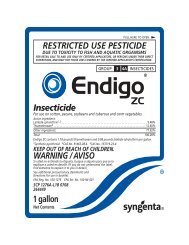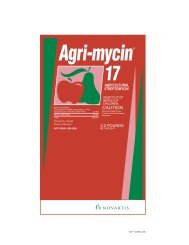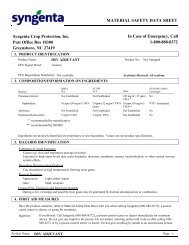Sweet Corn
Sweet Corn - Syngenta
Sweet Corn - Syngenta
Create successful ePaper yourself
Turn your PDF publications into a flip-book with our unique Google optimized e-Paper software.
<strong>Sweet</strong> <strong>Corn</strong>Crop Guide
Committed to Excellencefrom the field to the tableInnovating for the FutureBacked by global resources and a daily investment of more than $3 million in research and development, we bring to marketinnovative, integrated solutions that help ensure your high-value vegetable crops reach their full genetic potential. Our state-of-theartresearch facilities located across the U.S. are incubators for innovation in the field and in the marketplace, helping to ensure thatwe’re providing growers with the tools they need to put food on the table.We are committed to helping growers get the most from theircrops, both now and for generations to come. Partneringwith our customers every step of the way, we offer advanced,innovative solutions that provide growers with the tools theyneed in the field to ultimately put the food on the table. Afterall, our job is about helping customers deliver high-quality,nutritious vegetables to the market. We leverage our rich historyin the industry, strong presence in the market and significantinvestment in the future of agriculture to help you do just that.Partnering forSuccessOur roots in the vegetable industry run deep, tracingback to 1876 with the establishment of ROGERS ®brand seed. For more than 130 years, we have workedboot-to-boot with our vegetable customers to providea truly cutting edge, individualized approach to solutionbuilding. Our integrated portfolio of seed, traits, seedcare and crop protection products support your crop ateach stage of development, from seed to harvest, andeach stage of the market, from packer to plate.Woodland Research StationUndergoing a major expansion to enhance R&Dand seed production capabilities, this stationserves as a hub for cereal, corn, cucurbit andfruiting vegetable research in the CaliforniaCentral Valley.Pasco Seed Processing FacilityThis 40-acre, 200,000 square foot state-of-the-art facilityprocesses both large-seeded and small-seeded vegetables.It houses a unique, two-pass drying system that mostclosely resembles natural drying in the field. Seed is storedwithin optimal parameters of temperature and humidity,ensuring a consistent supply of high-quality seed.Vero Beach Research CenterThis industry-leading facility combines the latesttechnologies with practical, hands-on field testing.The 12-month growing season allows scientists togenerate multiple seasons of field data per year.Naples Research StationSyngenta ResearchStationsSyngenta SeedProcessing FacilitiesThis station lies just south of the frost line in Florida,allowing two generations per year of most crops. Itincludes more than 100 open-field acres and containsmore than 60,000 square feet of greenhouse space, aswell as controlled growth environments and laboratories.Addressing Whole-farm ChallengesWe understand that your challenges extend far beyond the field, and collaborate with industry partners to providewhole-farm service and support. Through programs like AgriEdge Excelsior ® , we provide growers with recordkeepingtools designed to improve business practices and assist them in meeting supply chain requirements andsatisfying consumer preferences. As an active member of Field to Market ® , the alliance for sustainable agriculture,we collaborate with fellow industry leaders to address the challenge of putting enough food on the table to meetthe needs of our rapidly growing population—both today and well into the future.Supporting the IndustryOur commitment to customer satisfaction extends beyond solutions,service, and support – it’s an investment in the future success of theindustry as well. We are proud to partner closely with industry organizations,such as the American Seed Trade Association (ASTA), California Associationof Pest Control Advisers (CAPCA), Produce for Better Health, ProduceMarketing Association and United Fresh Produce Association, as anadvocate for sustainable vegetable production and consumption.Proud ToSupport FFA
Triple<strong>Sweet</strong> ® Plus – setting a higher standardTriple<strong>Sweet</strong> Plus is thelatest advancement in theTriple<strong>Sweet</strong> product line.It features the sameexceptional quality andtenderness, but now it’seven sweeter tastingthanks to more supersweetkernels on every ear.Combined with an improvedshelf life, it is sure to bea hit at roadside standsand in local retail stores.Primus• First in a series of new Triple<strong>Sweet</strong> Plusvarieties from Syngenta• Marks the next generation of superioreating-quality corn• Exceptional flavor and sweetnessexceed standard Triple<strong>Sweet</strong> varietiesand bring customers back for more• Tender and extra sweet bi-color kernels,long ears and medium-sized huskspreferred for roadside and local markets• High resistance to southern corn leafblight and intermediate resistance tocommon rust and Stewart’s wilt• Approximately 81 days to maturityTriple<strong>Sweet</strong> hybrids boasting superior eating qualitiesWH0809This Triple<strong>Sweet</strong> has high-quality large ears and outstanding eating quality, making ita favorite for roadside markets.• Produces exceptional eating quality• Well suited for local and roadsidemarkets in the Midwest andNortheast• A white BC 0805-type• Approximately 80 days to maturity• Herbicide tolerance allows for flexibilityin weed management program to helpensure control of problem weedsProvidence• Outstanding eating quality• Well suited for roadside and localmarkets as well as home gardens• Approximately 82 days to maturityBC0822GH0851BC 0805Honey SelectBC0822 provides outstanding Triple<strong>Sweet</strong> eating quality with Attribute ® trait stack tominimize insect damage and costs — and maximize yield and quality.• Tender sweet kernels covering auniform ear length• Great tip cover and attractiveflag leaves• Ideal for roadside and local markets• Excellent rust resistance package• Approximately 77 days to maturity• Herbicide tolerance allows forflexibility in weed managementprogram to help ensure control ofproblem weeds• Long ears with good husk extension• Ideal for main-season plantings in theMidwest and Northeast• Approximately 80 days to maturity• Herbicide tolerance allows forflexibility in weed managementprogram to help ensure control ofproblem weedsAn industry standard for reliability of high yields and eating quality, BC 0805 ispacked with superior taste and eating qualities.• Well suited for main-season plantingsin the Midwest and Northeast• Long, well-filled ears• Outstanding eating quality withtender, sweet kernels• Approximately 82 days to maturity• Herbicide tolerance allows forflexibility in weed managementprogram to help ensure control ofproblem weeds• All-America Selections Winner• Exceptional tenderness, flavorand sweetness• Produces large, high-quality ears• Medium-green husks and good flags• Approximately 79 days to maturity
Supersweet (sh2) hybridsthat outperform in the fieldand the marketBattalionOffering superior eating quality, Battalion is a shipper hybrid that combinesimproved husk protection and excellent tip fill with a strong plant and good diseaseresistance package.• Bi-color with similar plant and ear toGarrison but with improved eatingquality and husk protection• Maintains ear size and tip fill duringfall and winter seasons• High resistance to Northern corn leafblight and common rust• Smaller-sized ears ideal for shippingmarket• Consistent performance in trials fromHomestead to New York• A Florida <strong>Sweet</strong> <strong>Corn</strong> Exchange brandaccepted varietyGSS 0966• Main-season yellow shipper corn withgood eating quality• Well-filled ears with glossy kernels andexcellent husk cover• Consistent performance• Approximately 78 days to maturity• Herbicide tolerance allows forflexibility in weed managementprogram to help ensure control ofproblem weedsProtectorProtector offers the most advanced genetics on the market forsweet corn producers, with industry-leading disease and abovegroundinsect control. This shipper offers consistent, high-yieldingperformance across most growing areas and seasons.• Strong husk protection,straight rowing and excellenttip fill on uniform ears ideal forshipping• Attribute II trait stackmaximizes yield andproductivity by deliveringunsurpassed control oflepidopteran pests• Herbicide tolerance allows forflexibility in weed managementprogram to help ensurecontrol of problem weeds• Wide area of adaptation andindustry-leading diseaseresistance package• Consistently high yieldsprovide continual profitopportunities for growersMunitionThis is a high-yielding white supersweet hybrid that produces a stylish shipper earwith uniform size, protected by a strong disease package.• Excellent tip fill appeals to freshmarket customers• Ideal ear size for crating in shippermarkets• Especially well adapted for regionsfrom south Florida to New York• High resistance to common rust andintermediate resistance to Stewart’swilt, northern corn leaf blight andmaize dwarf mosaic• Approximately 78 days to maturityWSS 0987• A consistent performing white for thefresh shipper market• High resistance to common rust andintermediate resistance to northerncorn leaf blight• Approximately 81 days to maturity• Herbicide tolerance allows forflexibility in weed managementprogram to help ensure control ofproblem weeds
Sugary/sugary enhanced (su /se)BSS0982BSS 0977Silver QueenSilver KingA high-yielding bi-color, BSS0982 is top of the line in outstanding eating enjoymentto meet the demands of discriminating shippers and consumers.• Exceptional eating quality• For high-end shipper and localmarkets in the West and Northeast• Large, attractive ears with goodkernel color contrast• Excellent disease package• Approximately 80 days to maturity• Herbicide tolerance allows forflexibility in weed managementprogram to help ensure control ofproblem weeds• Exceptional rust resistance package• Strong performing, widely adaptedbi-color shipper corn• Eye-catching, dark green husks• High-quality ears• Approximately 78 days to maturity• Herbicide tolerance allows forflexibility in weed managementprogram to help ensure control ofproblem weeds• The industry standard white “su”sweet corn• Superb eating quality• Attractive package• Elegant ears with flavorful,tender kernels• Approximately 88 days to maturity• This white ear has fabulous flavor andtenderness for local market growers andhome gardeners• Tight husk cover helps preventbird damage• Optimum ear placement makes for aneasy harvest• Approximately 82 days to maturityHeavenlySS Jubilee PlusHeavenly is a white supersweet variety with outstanding eating quality and strongconsumer appeal for the western U.S. shipper market.• Industry standard for eating quality• Excellent yellow-gold color• Strong performer in the West• Consistent eating quality• Deep kernels• Well-suited for multiple markets,including roadside stands• Especially well suited for growers andshippers needing a higher quality ear• Attractive white ears with deep kernels• Consistent yields and better pack outs• Approximately 78 days to maturity
Attribute II Provides Broad-Spectrum Control of Key <strong>Sweet</strong> <strong>Corn</strong> PestsEventProteinEuropean <strong>Corn</strong>Borer<strong>Corn</strong> Earworm Fall Armyworm Black CutwormThe Attribute ® II trait stack from Syngenta is the latest breakthroughin above-ground insect protection for sweet corn, deliveringunsurpassed control of lepidopteran pests to maximize yield, qualityand productivity.How It WorksThe introduction of the Attribute II trait stack continues the Syngenta tradition of providing highperformancetraits to sweet corn growers, and now it has the added power of Vip3A – a unique modeof action proprietary to Syngenta. The combination of Vip3A with Cry1Ab, the protein found in Attributeinsect-protected sweet corn varieties, offers excellent control of key yield-robbing insects includingEuropean corn borer, corn earworm and fall armyworm. Attribute II is also highly effective againstWestern bean cutworm, which has emerged as a serious and growing threat in many production areas.Attribute II Vip3A, Cry1Ab E E E VGAttribute Cry1Ab E F-G G PSeminisPerformanceSeriesCry1A.105, Cry2Ab E VG E PControl rating: E= excellent, VG= very good, F-G= fair to good, G= good, F=fair, P-F= poor to fair, and P= poor.Source: K. Flanders, et al. University of Alabama Cooperative Extension System 2010• Beet Armyworm(Spodoptera exigua)Attribute II Spectrum of Control• Dingy Cutworm(Feltia jaculifera)• Southwestern <strong>Corn</strong> Borer(Diatraea grandiosella)How VIP Differs from Cry ProteinsBoth vegetative insecticidal proteins (VIP) and crystalline proteins (Cry) are derived from BacillusThuringiensis (Bt). However, VIPs are an entirely new class of proteins that differ from their Cry proteincounterparts. Vip3A binds to different receptors than Cry proteins within an insect’s mid-gut membrane.Researchers have identified changes in the binding process as a factor in the development of resistantinsects. Expressing both VIP and Cry proteins, Attribute II insect protection greatly reduces the risk ofinsect resistance.• Black Cutworm(Agrotis ipsilon)• Common Stalk Borer(Papaipema nebris)• <strong>Corn</strong> Earworm(Helicoverpa zea)• European <strong>Corn</strong> Borer(Ostrinia nubilalis)• Fall Armyworm(Spodoptera frugiperda)• Southern <strong>Corn</strong>stalk Borer(Diatraea crambidoides)• Sugarcane Borer(Diatraea saccharalis)• Western Bean Cutworm(Striacosta albicosta)Conventional non-BtAttribute IIVIP proteinVIP protein bonding sitePore FormationMid-gutmembraneCry proteinCry protein bonding sitePore FormationBoth VIP and Cry-bound proteinscause formation of pore in mid-gut membraneMid-gutmembranePore formation results in insect deathSource: G. Dively, University of MarylandThe Complete PackageIn addition to its broad-spectrum insect control, the Attribute II trait stack includes tolerance to Liberty ® herbicide.Attribute II gives growers the flexibility to cater their herbicide program to effectively address problem weeds whilereaping the benefits of its superior insect control.
<strong>Sweet</strong> corn endosperm classificationThe endosperm is the primary food storage for corn seedand makes up most of the physical bulk of the seed. Thetype of endosperm in a sweet corn variety is importantbecause of the effect on planting seed and eating quality.The following chart contains general information. Eachvariety must be judged on its own merits.Sugary (su) typesThese are the original sweet corns used by your grandparents. Todaythe su varieties are known for superior seed quality, but generally lackappeal to the fresh market consumer. This is largely due to the lowersugar levels and rapid conversion of sugar to starch severely limitingthe shelf life of the su varieties.pros• Exceptional seed vigor and germination• Fast establishment• <strong>Corn</strong> flavor• Less ear damage during harvest• Usually reliable seed productionpros• Exceptional tenderness• Extra sweetness• Extended shelf life(1-2 days better than se)• Extended field holding ability (1-2 days)• Great for local and roadside markets• Same isolation as sugary (su) andse varietiescons• Lowest sugar at harvest• Lack of field holding• Fastest sugar loss after harvestTriple<strong>Sweet</strong> and Triple<strong>Sweet</strong> PlusTriple<strong>Sweet</strong> and Triple<strong>Sweet</strong> Plus varieties offer a new class of sweetcorn, containing 75 percent sugary enhanced (se) kernels and 25percent supersweet kernels and 56 percent sugary enhanced (se)kernels and 44 percent supersweet kernels respectively. Triple <strong>Sweet</strong>and Triple <strong>Sweet</strong> Plus varieties combine the exceptional tendernessand flavor of se varieties with extra sweetness, extended shelf-lifeand field holding ability; and deliver more consistent, longer-lastingsweetness, even under drought stress, making them ideal for roadsidemarkets and local shipping.cons• Can be damaged at harvest likese varieties• Shelf life is not as long assh2 varietiesGuide to growing sweet cornThe following tips and guidelines are designed to help you maximizethe emergence of your Syngenta sweet corn seed.Soil moisture/preparationAvoid moisture extremes such as heavy, poorly drained soils orextremely light, unevenly moist soils. Seed beds must be wellpreparedto maintain sufficient moisture at shallow planting depths.• <strong>Sweet</strong> corn seeds are most sensitive to cold, wet conditions duringthe first 24 hours after planting• Avoid planting right before a cold front and heavy rain• Provide adequate, even moistureType Kernel Composition % SugarSugary su 9–16SugarEnhancedTriple<strong>Sweet</strong>Triple<strong>Sweet</strong> Pluspros• <strong>Sweet</strong>ness• Tenderness• Flavor• Disease resistance• Same isolation as sugary (su) varietiesprosHeterozygous 50% seHomozygous 100% se75% se25% supersweet44% supersweet56% seSugary Enhanced (se) typesA relatively new type or class, the se varieties have been in use sincethe 1970s with the first scientific description in 1978. Se varieties havedramatically increased in popularity because of their sweetness, textureand consumer appeal. Se varieties also have an increased shelflife compared to the su types.• Very sweet• Increased sugar holding/shelf life in thefield and during post-harvest marketing• Increased harvest flexibility• Less sugar variation between environments• Less damage during harvest• Good shipping abilityconsSupersweet or Shrunken (sh2)• Less shelf life and fieldholding than sh2 varieties• <strong>Sweet</strong>ness performancevaries with climate• In general, less seed vigor andgerm than sugary (su) varietiescons14–2220–28Supersweet sh2 28–44This class or genetic type was first described in the 1950s with thefirst successful hybrid introduced in the late 1970s. Popularity of sh2varieties continues to increase due to the high sugar content and fieldholding ability. The increased shelf life improves distribution ease andallows for a high-quality product in the fresh market distribution chain.• Sh2 varieties have a reputation ofbeing “crunchy” with less corn flavorand lower seed quality• More difficult to plant and obtain stand• Physically weaker seed and issubject to breakage• Need isolation from all other typesSoil temperaturesWarm soil temperature is recommended. Planting sweet corn seedtoo early, in too cool soil is probably the single most commonreason for a poor stand. <strong>Sweet</strong> corn varieties exhibit the best emergencewhen soils can maintain 60 F to 65 F. At 50 F seed will imbibewater but won’t grow.Planting depthPlant the seed no deeper than needed to reach moisture and notmore than 1.5 inches. Best emergence occurs when seed is notplanted too deeply. Uniformity of planting depth is important. Checkfor proper seed placement.Grower guide forAttribute sweet cornAttribute ® and Attribute II sweet corn varieties from Syngenta are aviable crop strategy for sweet corn growers throughout the country.Commercially grown since 1998, Attribute sweet corn seeds providea high level of above-ground protection against targeted peststhroughout the growing season. With Attribute sweet corn, growershave another option for harvesting outstanding yields of high-qualitysweet corn that meets market needs. If properly managed, Attributesweet corn can be a valuable addition to your crop managementstrategy for many years to come.Attribute trait stack performanceSince the introduction of the Attribute trait stack, numerous field trialshave been conducted by Syngenta throughout the U.S. Results fromthese trials indicate that Attribute sweet corn showed significantly lessdamage from targeted pests, while non-Attribute protected plantssuffered extensive damage from European corn borers and cornearworms. As a result, Attribute hybrids are an effective strategy forcontrolling European corn borer and corn earworm insect populations.Results to date indicate that under most conditions, more than 95percent of Attribute plants remain virtually free of European cornborer and corn earworm damage throughout the growing season;however, the expected level of protection can vary depending uponenvironmental factors and seed purity. European corn borers andcorn earworms can migrate from non-Bt plant to Bt plants, so somecorn borer and earworm larvae may be seen on Attribute sweet cornthat borders non-Bt fields. Because European corn borers and cornearworms cannot distinguish between Bt and non-Bt hybrids, eggmasses may be found on Attribute plants. But once small larvaebegin feeding on them, they quickly ingest the Bt protein and die. Tooptimize yields and ear quality, scout fields for pest outbreaks, andwhere necessary, apply chemical insecticides to prevent economic loss.Insect pests which are not controlled by this Bt protein include: cornrootworms, cutworms, common stalk borers, silk fly larvae, sap beetles,aphids and flea beetles. Attribute II, which combines Vip3A with the Btprotein found in Attribute, does provide control of several additionalpests including black cutworm and Western bean cutworm. However,where possible, consult your area pest management specialists or localextension agents for additional insight on pest outbreaks in your areaand suggested control options.IPM strategiesAttribute sweet corn is an important IPM tool that can reduce the needfor chemical pest control. Unlike broad-spectrum insecticides, whichcan destroy beneficial insect populations, Attribute sweet corn is notharmful to ladybird beetles, lacewings and other beneficial insects.While Attribute sweet corn can be a powerful IPM tool to controlEuropean corn borers and corn earworms, it is not an end-all solutionfor pest control. Years of IPM experience have shown that usingmultiple-control tactics over time is the best strategy for preservingecological diversity. Under high corn-earworm pressure found inthe southern half of the U.S. and with late-season planting, somepest damage can occur in Attribute sweet corn fields. If the marketrequires close to zero insect damage, some chemical control methodsmight be necessary. The number of applications and timing of theseapplications depend on the corn earworm pressure and environmentalconditions. Continue to use conventional insecticides judiciously tocontrol infestations of pests that are not controlled by Attribute sweetcorn. A multifaceted approach, including practices like crop rotationand tillage, can go a long way toward controlling pest pressure.Insect resistanceEvery pest management strategy must address the possibility thattarget insects could develop resistance to the pest control measures.So it is important to understand how resistant insect populations occur.Genes for resisting virtually anything may exist in nature, due torandom genetic variability and the constant shuffling of thousandsof genes through mating. Insects do not develop resistance genesthrough exposure to an insecticide. However, the insecticide doesselect the resistant insects that exist in the population by eliminatingthe non-resistant insects.As the insecticide kills the insects that don’t have resistance genes,the survivors begin to dominate the breeding process. They passtheir resistance genes to future generations, and as these populationsincrease, they eventually become predominant and the insecticidebecomes ineffective.What to do if you observe unexpected damageIf you observe unexpected damage from target pests, call this toll freenumber and report what you have observed.1-877-GRO-CORN (1-877-476-2676)8 a.m. – 5 p.m., Monday through Friday, Mountain TimeA Syngenta representative will investigate the situation. After ruling outother possible causes and testing to verify that the plants carry theproprietary Bt gene, the representative will collect European corn borersor corn earworms for laboratory assay tests. If resistance is suspected,Syngenta will inform customers and extension agents in the affectedarea, as well as EPA officials. Insect monitoring programs will beincreased and alternative control measures will be recommended.Partners in resistance preventionInsect resistance is a real possibility and should be taken veryseriously. Failure to follow resistance management measures couldlead to the development of resistant populations. All levels of theproduction chain, from the grower to the seed industry, must worktogether. Each of us has a responsibility to manage this exciting newtechnology carefully and preserve its long-term value for growers,consumers and the environment.
Focused Innovation to Meet Grower NeedsSyngenta is committed to helping you produce the highest-quality crop possible, delivering advanced,integrated solutions that combine our industry-leading seed, trait, seed care and crop protection offerings.Technical data: sweet cornVarietyEndospermtypeKernelcolorApprox.days tomaturityAvg. earlength(in)Avg. eardiameter(in)Avg. rowcountHuskappearanceDisease resistanceTriple<strong>Sweet</strong> ® PlusPrimus Triple<strong>Sweet</strong> Bi-color 81 8 1.8 14-16 Medium green HR: BmIR: Pst / PsBesiege ® foliar insecticide combines two activeingredients in a convenient, economical premixformulation to provide fast knockdown and long-lastingresidual activity on key lepidopteran pests, as well aseffective control of multiple stink bug species. Besiegedelivers consistent, high-level control in vegetable crops,including those with emerging pyrethroid resistance.Powered by mesotrione, an HPPD mode of action andthe foundation of Callisto Plant Technology ® , Callisto ®herbicide delivers unmatched contact and residualcontrol of the toughest broadleaf weeds, flexibleapplication timing and excellent crop safety.Cruiser ® seed treatment insecticide offers growersimmediate protection against early-season insects.Thiamethoxam, the active ingredient in Cruiser, helpsto improve plant stands and can help maximize yieldpotential. Delivered on-the-seed, Cruiser offers aconvenient way to get crops off to a successful start.Quilt Xcel ® fungicide elevates sweet corn to its full yieldpotential by shielding plants from stress. With Quilt Xcel,plants are able to counteract conditions of too little ortoo much water while maximizing the sun’s energy forextended grain fill. Quilt Xcel provides preventive andcurative disease control and the systemic xylem mobilityof its active ingredient provides uniform disease controlthroughout the plant, even to new growth.Triple<strong>Sweet</strong> ®BC0822 Triple<strong>Sweet</strong> Bi-color 77 8 1.8 14-16 Medium green with goodhusk extensionHR: PstIR: Bm / Et / Ps (Rp1-d), Ps (Rp1-g)Honey Select Triple<strong>Sweet</strong> Yellow 79 8.5 1.9 18-20 Medium green IR: PstGH0851 Triple<strong>Sweet</strong> Yellow 80 8 1.8 16 Medium green with good HR: Bm / Ps (Rp1-d)husk extensionWH0809 Triple<strong>Sweet</strong> White 80 8 1.8 16 Medium green HR: Ps (Rp1-g)IR: BmAvalon Triple<strong>Sweet</strong> White 82 8 1.7 16 Medium green IR: Bm / Et / PstBC 0805 Triple<strong>Sweet</strong> Bi-color 82 8 1.7 14-18 Medium green HR: Ps (Rp1-d)Providence Triple<strong>Sweet</strong> Bi-color 82 8 1.7 14-18 Medium green HR: Ps (Rp1-d)IR: BmSerendipity Triple<strong>Sweet</strong> Bi-color 82 8 1.8 16-18 Medium green IR: BmSupersweetSnow Basin sh2 White 76 8 1.8 16-18 Dark green with good flags HR: Ps: (Rp1-d)IR: Et / Pst / MDMV: ABattalion sh2 Bi-color 77 7.5 1.75 16 Medium-dark green,medium-long flags leavesBSS 0977 sh2 Bi-color 78 8 1.8 14-16 Dark green withmedium flagsGSS 0966 sh2 Yellow 78 8 1.8 16-18 Dark green withgood flagsHeavenly sh2 White 78 8 1.9 16 Dark green,medium-long flagsMunition sh2 White 78 7.5 1.8 16 Dark green withgood lengthGarrison sh2 Yellow 79 8 1.8 18 Medium dark green withmedium long flagsLegion sh2 Bi-color 79 8 1.8 18 Medium-dark green withmedium-long flagsProtector sh2 Yellow 79 8 1.8 18 Medium-dark green withmedium-long flagsBSS0982 sh2 Bi-color 80 8 1.8 16 Dark green, very long andshiny flagsWSS 0987 sh2 White 81 7.2 1.8 14-16 Dark green withgood flagsSS Jubilee Plus sh2 Yellow 83 8.5 1.9 16-20 Medium green HR: Ps (Rp1-d)IR: BmHR: Et / Ps: (Rp1-i) / MDMV: AIR: PstHR: Ps (Rp1-d), Ps (Rp1-i)IR: Et / PstHR: Ps (Rp1-i)IR: Et / PstHR: Ps (Rp1-d)IR: Bm / MDMVHR: Ps (Rp1-d), Ps (Rp1-i)IR: Et / Pst / MDMVHR: Bm / Et / Ps (Rp1-d), Ps (Rp1-i) /Pst / MDMVHR: Et / Ps (Rp1-d), Ps (Rp1-i) / MDMVIR: Bm / PstHR: Bm / Et / Ps: (Rp1-d), Ps (Rp1-i) /Pst / MDMVHR: Ps (Rp1-d)IR: Bm / MDMVHR: Ps (Rp1-d)IR: EtSugary/Sugary enhancedSilver King se White 82 8 1.9 16-18 Medium green withIR: Bm / Et / Pst / Psgood coverSilver Queen su White 88 8 1.8 14-16 Dark green HR: Et / Pst / PsIR: BmDisease abbreviation keyBmEtSouthern corn leaf blight caused by Bipolarismaydis (= Helminthosporium maydis)Northern corn leaf blight caused byExserohilum turcicum(= Helminthosporium turcicum)MDMVPsPstMaize dwarf mosaic virusCommon rust caused by Puccinia sorghi(Rp1-d, e, g, i) controlled by the Rp1-d,e, g, and i genes (see *footnote below)Stewart’s wilt caused by Pantoeastewartii (= Erwinia stewartii)sesh2suHRIRSugary enhancedSupersweetSugaryHigh resistanceIntermediate resistance**Footnote to sweet corn: the effectiveness of rust resistance genes in sweet corn will be determined by the variation of common rust races in each growing environment. Rust races are continuallyevolving, so that rust resistance genes that were effective in the past may suddenly and unexpectedly lose their effectiveness. It is necessary to scout for rust disease development, so thatalternative disease control strategies can be deployed in the event that major gene resistance proves ineffective. Syngenta Seeds is an associate member of the International Seed Federation andsupports the initiative to use consistent terminology to describe plant diseases and resistance. For further information, see http://www.worldseed.org/isf/diseases_resistance.html.In cases where specific races or strains are not noted, the variety is resistant to some, but not necessarily all known races or strains of the pathogen. For complete disease resistanceinformation, please visit www.vegetables.syngenta-us.com.





